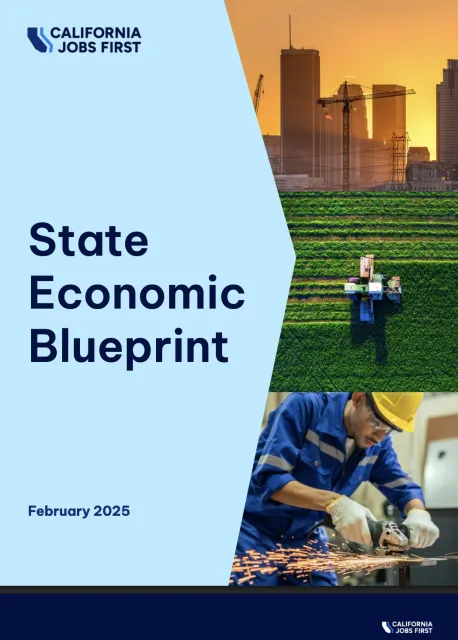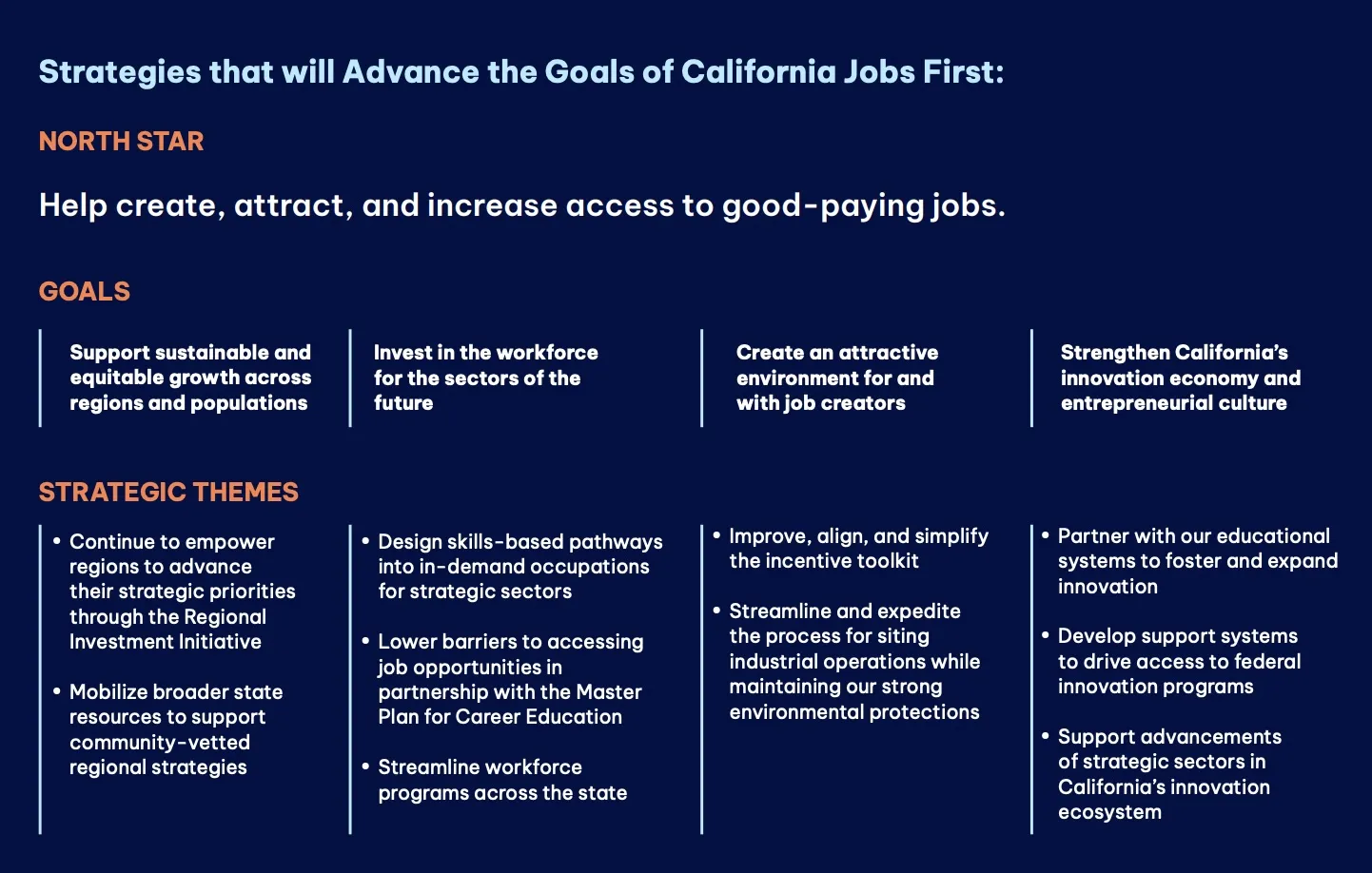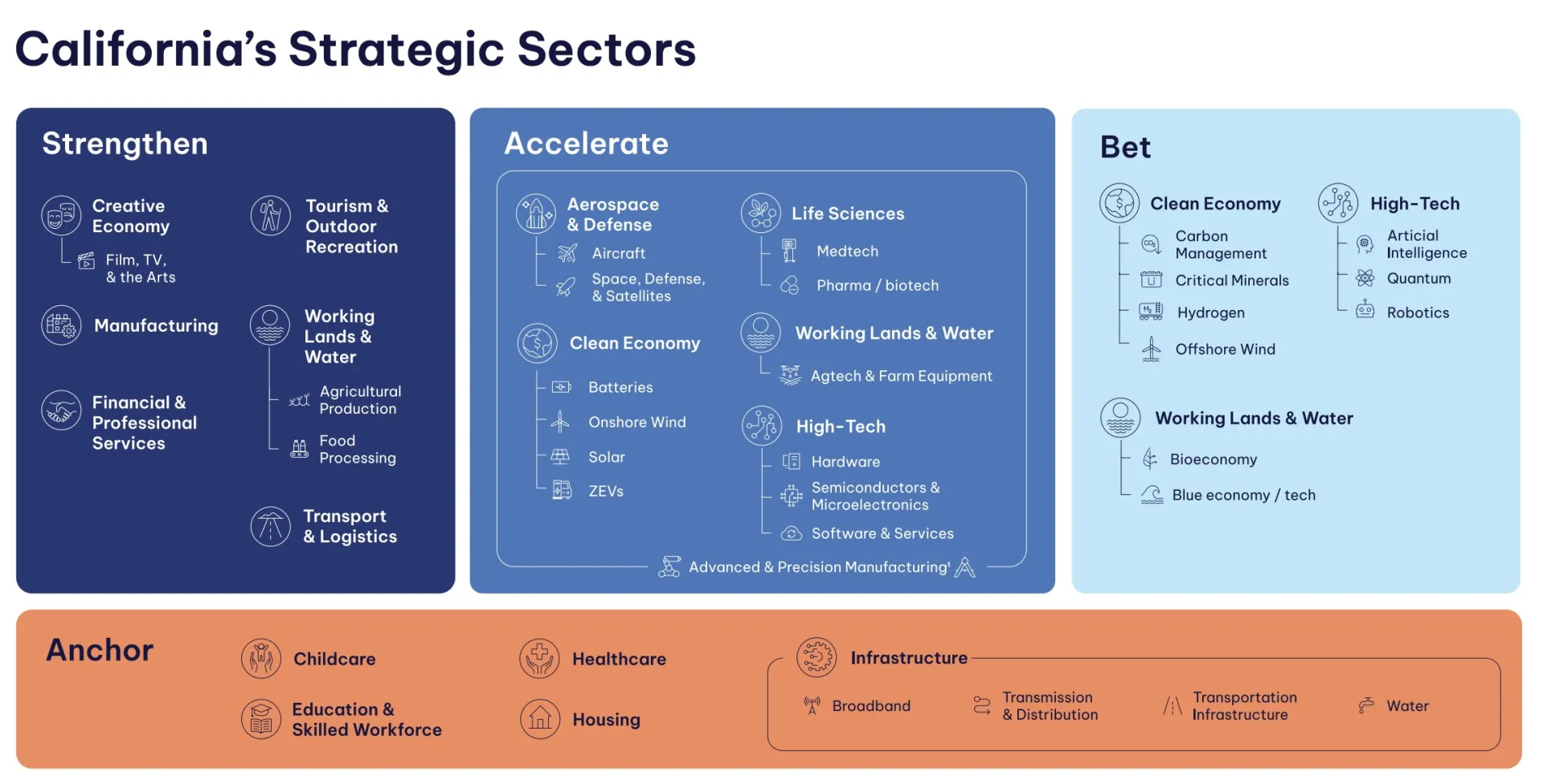Commentary on the California Economic Blueprint from University of California Cooperative Extension Advisors in two rural regions
I recently had the opportunity to co-present with my colleague Alec Dompka, UC Cooperative Extension Community Economic Development Advisor for the North Coast, to share some reflections on the California Economic Blueprint—a 10-year strategy and roadmap for economic development in California. (I serve in a parallel role as a UCCE CED Advisor for the Eastern Sierra region convering Inyo and Mono counties.) We have each been involved in our regional processes as local supporters and practitioners. We approach the topic with observations from different corners of the state about what the Blueprint might mean in our regional, rural communities. We intend this piece as a conversation starter for our local partners and state-level people with an interest in rural communities, rather than a systematic, comprehensive assessment.

The Blueprint was released earlier this year on the heels of 13 regional strategies that came as part of the broader California Jobs First (formerly Community Economic Resilience Fund [CERF] initiative), which has supported regional planning and project development. Research and strategy development began in late 2022 and early 2023, with the goal of guiding pre-development grant funding, followed by an Implementation tranche of funding in what is effectively a phased approach to development. Regional strategies were released in early Fall last year, and a first round of pre-development funding, the Catalyst fund, are reaching communities presently.
The initiative represents a landmark strategy and round of investments in the field of community economic development in California. Some have described the initiative as a generational opportunity that is unlikely to be repeated soon due to the scale of community engagement and planning that has taken place over the last three years. As such, the effort merits reflection for the opportunities it has brought, and also the challenges and gaps that have surfaced during the process. We offer some thoughts from our rural regions.
Why the Blueprint Matters to Rural California
Our respective rural regional California Jobs First strategies (Sierra Jobs First and Redwood Region Resilient Inclusive Sustainable Economy [RISE] make clear the pressures rural California is under. Climate change brings heat events and wildfires. Rural earnings and innovation indicators severely lag metropolitan California. Cost of living and housing challenges persist and worsen in many rural communities. Local development stakeholders continue pursuing opportunities to generate new industry activity, but economic diversity remains elusive. Workforce pathways and educational attainment remain areas of opportunity, but again, rural California lags behind its urban neighbors in building technical training programs and retaining young talent. Latino and tribal partners are too often not included in public processes, owing to historic divisions and a continued lack of intentional capacity building. The list goes on, as our locally-led research and strategic plans outline–the strategy reports detail more than we can here. There are similarly long lists of the assets and opportunities that our communities surfaced.
The Blueprint tries to connect local strategies to a larger state vision for inclusive, resilient economic growth: through coordination, technical assistance, directing investment, and aligned approaches, the framework aims to leverage resources for joint partnerships and approaches that can elevate multiple places at once. Often, the Blueprint offers a vision that our local stakeholders can rally behind, a shared set of goals and strategies that make sense for urban, suburban, and rural California. At other times, it reads like a document that’s intended for distant places that does little to emphasize places like ours that struggle to provide basic services, shore up aging infrastructure, and build the kind of creative leadership capacity that might allow us to plan, develop, and flourish. We asked a few key questions in our reading:
What parts of the Blueprint are relevant for rural regions?
Where do we see alignment—or misalignment—with local priorities?
What opportunities does the Blueprint open up for capacity-building and partnerships, especially to build regional leadership capabilities that are so crucial to rural places?

Observations and Takeaways
Rural Capacity and Collaboration
It's encouraging that the state worked with the U.S. Economic Development Administration to recognize CJF strategic plans as equivalent to Comprehensive Economic Development Strategies (CEDS), opening up access to federal funding for regions without an existing CEDS, and refreshing or complementing those regions with existing plans. The Blueprint rightly emphasizes stronger regional coordination across the state. But it offers no detail on how rural regions will be able to sustain long-term coordination and development capacity that the initiative set out to produce with its support for regional coordinating conveners beyond the 2026 sunset of the California Jobs First initiative.
Many rural areas still lack the sustained support and resources needed to regularly convene stakeholders and sustain cross-sector collaboration. It was a yeoman’s (and often volunteer) effort to produce the research and strategic plan over a nearly two year period, just as often successful at building capacity and uncovering opportunities as it was eliciting frustration and confusion. As the Blueprint moves forward as a guiding framework, rural leadership and convening capacity deserve protracted, long-term investment—through capacity grants, coordinated policy and braided funding, multi-faceted technical assistance, leadership development for young emerging leaders and veteran executives, and other tools to build long-term regional resilience. Programs like CALED’s Rural Exchange offer promising models for peer learning and cross-regional collaboration. CAFwd, California’s “good governance” and economic prosperity champion, with its Stewardship Network of regional leadership groups, has had some encouraging rural-oriented initiatives in years past that merit new energy and attention. Other organizations (RCRC, CSAC, ILG, RCAC, others) offer technical assistance and other support in rural places. But the Blueprint leaves open questions surrounding how state agencies and public-private partnerships will broadly, actively support and scale efforts to strengthen both emerging and more developed rural collaboratives and initiatives across California.
Modernizing State Agencies, Guiding Economic Strategy
Part and parcel of the needs around regional leadership and convening capacity issues just mentioned, the Blueprint suggests the CA Labor and Workforce Agency and the Governor’s Office of Business and Economic Development will “modernize,” including the creation of an Office of Regional Economic Development Initiatives, presumably that would build on the work of California Jobs First. A few states, such as Wisconsin, Michigan, and Kansas, have established Offices of Rural Prosperity to address rural needs, provide technical assistance, and enhance public-private partnerships and cross-agency coordination. We look forward to seeing specific plans for California's state agency reforms, and how public-private partnerships between regional consortia and state actors can create, leverage, and elevate rural strategies. Ultimately, we are hoping to support efforts that will provide pathways and roadmaps for how rural California can partner in crafting policies and strategies that will enhance regional coordination between the state and local, regional rural actors.
Rural Healthcare and Anchor Investments
One place where rural challenges and opportunities come into partial focus is in the Blueprint’s section on Anchor Investments—areas like healthcare, housing, broadband, childcare, and workforce development that are foundational for regional economic growth. The Blueprint outlines the importance of these anchors generally, but offers limited specifics on their centrality to rural success. The healthcare section, in particular, stands out for its emphasis on expanding access through mobile and telehealth solutions—a rare, specifically rural example in the section. This kind of targeted strategy across regions would be encouraging, especially given the persistent struggles rural hospitals face with staffing, facilities, and financial viability.
But the lack of rural specificity across anchor sectors in the Blueprint also raises a bigger question: what would it look like to apply the same level of coordination and investment strategic focus across all anchor areas, taking a comprehensive approach across rural California regions? In many small communities, local governments and convening organizations are already stretched thin, but desperately need capacity for cross-sector, regional approaches to address common challenges. Without dedicated support for regional convening, implementation of these anchor investments risks being piecemeal or inaccessible. How will rural partners be meaningfully involved in shaping and delivering these foundational systems in the state’s framework for the future? How will the state act as a coherent, consistent supporter for creating and establishing such a vision and the capacity to implement it in rural parts of the state? The Blueprint does not address these issues.
Workforce and Talent Pipelines
Speaking of anchor investments, the Blueprint goes a long way in emphasizing workforce development, putting a spotlight on the California Master Plan for Career Education and its focus on emerging standard practices such as work-based learning, credit-for-prior-learning, and industry-aligned credentials. Workforce development—long supported across party lines—makes sense for business and, with thoughtful outreach, can advance equity goals by helping families increase their earnings. This is true in rural and metropolitan California.
Rural communities face unique workforce development challenges that call for additional strategic focus and programmatic investment. This includes innovations to support quality job creation in small businesses across sectors like natural resource management (forest management), outdoor recreation and tourism, manufacturing, and remote STEM work, including creative and knowledge economies. In rural areas, both business needs and workforce realities often require different approaches than those used in High Road Training Partnerships (HRTPs), the state’s preferred workforce framework, a product of UC Labor Centers, which typically operates at a large scale in metro regions through complex, multi-stakeholder labor-public-private partnerships. That said, the Blueprint’s broader vision of quality jobs and high road partnerships—building school-industry collaboratives, expanding access to health and retirement benefits, outlining career advancement pathways, building education and training programs, increasing wages, and reducing turnover—are noteworthy goals that are relevant and desperately needed in rural places.
Many rural areas also face persistent barriers related to educational attainment, reductions in working-age population, affordability, broadband access, and resource availability that shape the workforce context. These issues require tailored strategies led by local, regional public-private consortia. There are national programs to draw from, including the USDA’s Rural Workforce Innovation Network and the university Extension-led FORWARD (Future Opportunities for Rural Workforce and Rural Development) curriculum. With a more intentional rural emphasis, California could adapt and expand on these examples and develop its own innovative workforce strategies and case studies.
Revisiting Our Regional Priority Sectors Alongside the Blueprint
The state has opted to prioritize investments in what it labels the "Accelerate" and "Bet" categories that promise transformational development possibilities for the state. Many of these are aspirational, technology innovation plays–like bioeconomy, clean energy, and carbon storage–that may offer opportunities for rural regions. But it is not clear how many of the sectors will directly benefit rural communities without further planning and program development, or a complimentary framework that better addresses specific rural needs. Moreover, our regional priorities–healthcare (and other anchor sectors), outdoor recreation and tourism, and sustainable agriculture and food systems–will have to seek other sources of funding: the Blueprint’s framework disqualifies most of our strategic priorities as ineligible for the final-stage Implementation round of funding. The Blueprint’s approach further invites discussion about how the state plans on envisioning or developing coherent economic strategy in partnership with its rural areas.

Bioeconomy (and Forest Management)
Multiple state agencies and policy reporting have emphasized the need to develop viable markets for biofuels (including hydrogen) and various types of wood products to address wildfires. However, these downstream, demand side activities dominate the Blueprint’s description of the bioeconomy—one of the state’s priority “Bet” sectors. Developing these markets depends heavily on upstream activities in rural forested communities, the fuels reduction and forest management activities that are needed to build an entirely new, vertically integrated supply chain required to create new markets in biofuels and new wood products.
The Blueprint should have more explicitly emphasized the sector’s upstream supply chain components—the forest management activities, and the local permitting, processing, logistics, and site-specific bioenergy opportunities that accompany them. Various boots-on-the-ground activities are essential for wildfire mitigation and ecological health but receive limited attention in the Blueprint. Yet they represent a potentially major job source in rural forest communities, as policy prerogatives will scale the need for these workers and new businesses to perform the work. Fuels treatment and forest management requires project permitting and assessment technicians, foresters, equipment operators, loggers, truck drivers, logistics workers, and fuels treatment and conservation crews—critical occupations needed to meet the state’s goal of treating 1 million acres of forest annually.
While more consistent research is needed on employer demand for these jobs (there are too few studies and regular tracking data), reporting and stakeholder engagement through the Wildfire and Forest Resilience Task Force have consistently pointed to current and projected workforce shortfalls in these front-line forest management roles. (Initiatives like the community colleges California Resilient Careers in Forestry, and multiple tribal cultural burning practices are noteworthy, but nowhere mentioned in the Blueprint.)
Outdoor Recreation and Tourism
Research consistently suggests that rural places with outdoor recreation “amenities” have shored up population losses when compared to non-outdoor rec rural counterparts, though many have become victims of their own success with overcrowding and other sustainability (destination management) challenges. Several regions designated outdoor recreation one of their focused Jobs First sector priorities, including our own two rural regions. When combined with Creative Economy and Knowledge Economy strategies, a focus on outdoor recreation could set out to attract and retain high tech talent. The pitch? Rural places boast a quality of life and recreational amenities that are unmatched anywhere else.
With virtually no intentional strategic focus, rural places in California saw amenity migration gain steam during the pandemic. (The phenomenon generated mostly impact mitigation strategies in the aftermath.) These newcomers sometimes demand, fund, and support local improvements that, when done with effective convening and leadership, can benefit long standing residents and generate new visitor activity that present business and workforce opportunities. Given strategic development and organizational support, we can leverage the energy and excitement of newcomers to support efforts that many community members can get behind: downtown revitalization, support for arts and cultural events, new programs in local schools, entrepreneurial support systems, philanthropy and volunteerism, etc.
We appreciate that outdoor recreation and tourism (and Creative Economy) are recognized among the top priority sectors in the Blueprint. However, they were excluded from eligibility in the Implementation round of funding. Moving forward, we believe additional research, technical assistance, and partnership development are needed to better support the development of the strategic role these sectors can play in California’s rural economic development.
Working Lands and Technology Innovation for Rural Benefits
Working Lands is a broad brush stroke “sector” in the Blueprint, encompassing everything from agriculture production and processing, agricultural technology R&D and technology incubators, farm equipment, bioeconomy, and blue economy (aquaculture). Many of these are likely to have applications in major producing regions of the state like the Central Coast and San Joaquin Valley. We will be watching for clarification in our further state-level engagement to see how these initiative areas translate to applicability to the forested rural communities, whose family-run farms largely produce livestock, alfalfa, and other crops in pockets. In addition, the report does little to highlight the food systems strategies and investments that surfaced as priorities in multiple regions, urban, suburban, and rural. (The Sacramento region’s We Prosper Together initiative is notable in its ag and food systems strategies and Catalyst investments.) Here, there are statewide proposals that would likely benefit all areas simultaneously, given shared supply chain infrastructure, and approaches like food hubs, farmers markets, and agritourism.
Conclusion
We invite opportunities to tackle these issues, and to contribute to strategic development across the state and in our own regions. The University of California Cooperative Extension and its sister entities in the UC Division of Agriculture and Natural Resources, the Agriculture Experiment Stations (AES) and Research and Extension Centers (REC) are tackling a wide range of related research, education, and public engagement efforts to boost the state’s agriculture, natural and working lands, and rural communities and economies.
We understand that we live in a massive state with infinite competing, sometimes contradictory, sometimes complementary interests and forces that challenge approaches that will have universal acceptance and benefit. California is compelled to drive technological innovation that transforms the global marketplace while expanding access and opportunity across more strata and among more members of our local communities. Nonetheless, we think it is crucial that California do more to intentionally focus on the most rural, isolated, and under-resourced parts of the state with a more focused, coherent, and sustained approach than what is offered in the Blueprint. We plan to continue addressing the ways in which urban California is inextricably entwined in rural California in our research, writing, and program activities, and innovative approaches that are working in California and across the nation. For now, we offer these few observations in the hopes of sparking conversation.
We invite dialog and feedback. Please feel free to reach out with your own observations, questions, and responses.
************
Aaron Wilcher, UCCE CED Advisor, Eastern Sierra region, awilcher@ucanr.edu
Alec Dompka, UCCE CED Advisor, North Coast region, addompka@ucanr.edu
